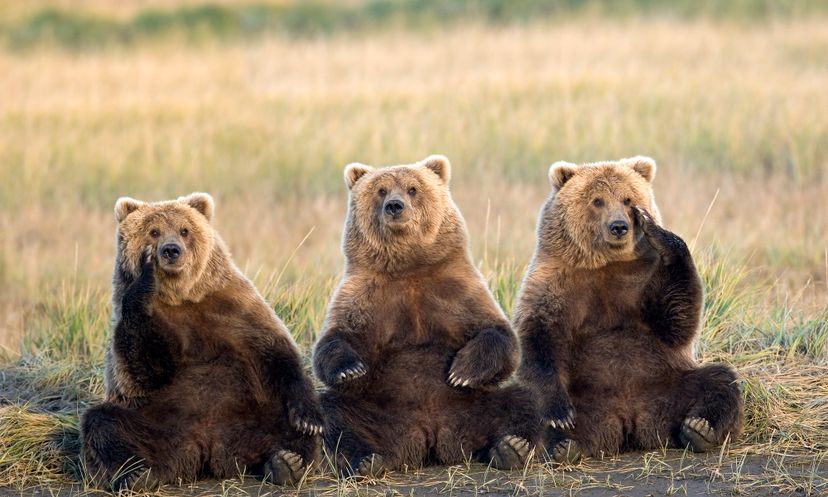
About This Quiz
There's Paddington Bear, Winnie the Pooh, Rupert Bear and many more. While kids may like to snuggle up with their teddy bear, real bears are wild creatures that can be very dangerous. There are many different kinds of bears, each with different characteristics and habits. Take this quiz to learn more about bears.Most bears live north of the equator. There are no bears in Africa, Australia or Antarctica.
Kodiak bears are the largest, weighing in at around 1,700 pounds (770 kilos) and reaching 10 to 12 feet (3.7 meters) in length. The sun bear of the Malay Peninsula, sometimes called the Malay bear, is the smallest type of bear. They weigh between 60 and 100 pounds are about three feet long.
Bears usually have poor eyesight and hearing. However, they have a very keen sense of smell, which aids them in hunting.
Advertisement
A bear is well protected from bee stings by its thick fur. The only unprotected part of a bear's body is its nose. Aside from honey, bears also eat fish, small mammals, fruit, roots, seeds, insects and carrion.
Sun bears are different because of their short fur, which is not shaggy like other bears. They also have a white or yellow marking on their chest which people believe looks like a rising sun, which is how they got their name.
The American black bear is the most common bear species in North America. Although some male black bears can weigh up to 900 pounds, most black bears weigh around 300 pounds. They live in the mountainous or heavily wooded areas of southern North America, the Appalachians, the Adirondacks, the Great Lakes region, the Rocky Mountains and Canada.
Advertisement
Black bear cubs usually weigh less than a pound when they are born in the winter. They are blind, furless and for about 40 days do nothing but eat and sleep, curled up with their mother in the den. However, by the following fall, the bears weigh about 40 pounds.
The glacier bear is a rare species of the American black bear. The glacier bear has a mix of gray and black hairs, making it appear a blue color. In fact, despite their name, black bears come in many different shades and colors. Kermode black bears are often a creamy or sometimes pure white and the cinnamon black bears are a rusty brown color.
A grizzly bear has a brown layer of under-fur, which lies close to the skin. It also has outer hairs which are white or silver-tipped. The mix of these hairs, giving a streaked gray "grizzled" appearance, is how the bear got its name. Grizzly bears can be quite dangerous, especially when injured, and have also attacked humans unprovoked.
Advertisement
Grizzly bears may eat 80 to 90 pounds of food each day in the summer and early fall. This amount increases as the bears prepare for the winter, building a layer of fat that will help them to keep warm and survive.
Grizzly bears live, hunt and feed alone. They don't communicate much, but it is thought that they use their claws to scratch bark of trees, leaving behind their scent so that other bears know the grizzly is around and will keep away.
Grizzly bears come together in the summer when the streams fill with salmon, an important part of a grizzly's diet.
Advertisement
Kodiak bears love salmon and are excellent fishers. Conveniently, they live on Kodiak Island, off the coast of Alaska, which is a spawning ground for salmon. A mother Kodiak bear can catch 15 salmon in an hour to feed herself and her cubs.
Polar bears have slip-proof bristles on their feet.
Polar bears do not live at either of the poles. Rather, they are found in the Arctic region around the North Pole.
Advertisement
Polar bears are better at swimming than any other bear. Than can swim at speeds of three to six miles an hour, thanks to their large forepaws that act like paddles and webbing between their toes. They have long necks, which helps them keep their head above water.
Polar bears have a thick layer of fat beneath their skin for insulation and their fur is made up of an overcoat and an undercoat. The fine, white hairs of the undercoat provide warmth, while the long guard hairs of the overcoat shed water easily and mat together to trap heat from the sun inside them. Polar bears have fur on their paws to keep their feet warm and their black skin absorbs heat.
Polar bears love ringed seal. When they spot a seal sitting on an ice floe, they swim up to it with only their head above water and pounce on the seal. They sometimes sit next to a seal's breathing hole in the ice and grab the seal when it comes up for air.
Advertisement
Sloth bears love to eat termites. The roof of a sloth bear's mouth is hollowed out, creating a vacuum effect when the sloth bear sucks up termites. The sloth bear inserts its mouth into a termite pillar and sucks up the insects, creating a sucking noise that is so loud it can be heard 200 yards away!
Spectacled bears climb trees and stay in the tree for three or four days eating its fruit before they move on to the next tree. Orchard farmers find these bears a nuisance, but spectacled bears scatter the seeds of trees and other plants, making them important for forest growth.